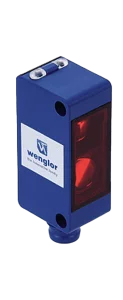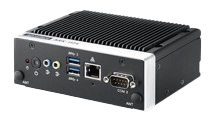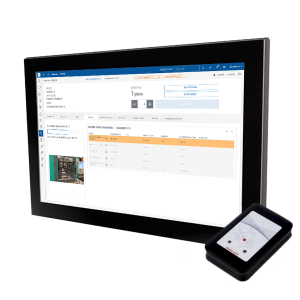Inteligentna fabryka to zakład produkcyjny, który wykorzystuje zaawansowane technologie do gromadzenia i analizowania danych, automatyzacji procesów i podejmowania decyzji w czasie rzeczywistym. Inteligentne fabryki są bardziej wydajne, produktywne i zrównoważone niż tradycyjne fabryki. Mogą wytwarzać produkty wyższej jakości po niższych kosztach i szybciej reagować na zmiany popytu.
Inteligentna fabryka to podstawowy termin koncepcji Przemysłu 4.0 (czwartej rewolucji przemysłowej) i ostateczny cel procesu transformacji cyfrowej.
Jaka jest różnica między tradycyjną fabryką a inteligentną fabryką?
W standardowej fabryce operacje są w dużej mierze wykonywane ręcznie i na papierze. Dane są gromadzone i wprowadzane do systemów ręcznie, a komunikacja jest często powolna i nieefektywna. W rezultacie standardowe fabryki mogą być podatne na błędy, opóźnienia i marnotrawstwo.
Z drugiej strony, inteligentne fabryki wykorzystują czujniki i inne urządzenia do zbierania danych z maszyn i procesów w czasie rzeczywistym. Dane te są następnie analizowane przy użyciu sztucznej inteligencji i uczenia maszynowego w celu identyfikacji trendów, wzorców i potencjalnych problemów. Informacje te są następnie wykorzystywane do optymalizacji operacji, poprawy jakości i szybszego podejmowania lepszych decyzji.
| Cecha | Standardowa fabryka | Inteligentna fabryka |
| Gromadzenie danych | Podręcznik | W czasie rzeczywistym |
| Komunikatywność | Powolny i nieefektywny | Wydajny i szybki |
| Raportowanie | Duplikat | Pojedyncze źródło prawdy |
| Wskaźniki | Niedokładny | Dokładne |
| Dokumentacja | Papierowe | Cyfrowy |
| Błędy | Wysoki | Niski |
| Reakcja na błędy | Opóźniony | Natychmiastowy |
| Czas przestoju | Wspólny | Rzadki |
| Kontrola nad maszynami | Ograniczony | Kompleksowość |
| Zarządzanie zapasami | Nieoptymalny | Wydajność |
| Zużycie mediów | Niekontrolowany | Kontrolowany |
| Emisje gazów cieplarnianych | Nierozliczone | Rozliczone |
| Gotowość do zmian | Niski | Wysoki |
| Zrównoważony rozwój | Niski | Wysoki |
W inteligentnej fabryce czujniki i inne urządzenia zbierają dane z maszyn i procesów w czasie rzeczywistym. Dane te są następnie analizowane przy użyciu sztucznej inteligencji i uczenia maszynowego w celu identyfikacji trendów, wzorców i potencjalnych problemów. Informacje te są następnie wykorzystywane do optymalizacji operacji, poprawy jakości i szybszego podejmowania lepszych decyzji.
Wprowadzenie do automatyki przemysłowej
Wprowadzenie automatyki przemysłowej ma długą i bogatą historię, sięgającą początków XIX wieku. Pierwsze urządzenia automatyki przemysłowej były prostymi maszynami używanymi do automatyzacji powtarzalnych zadań, takich jak tkanie i przędzenie. Wraz z postępem technologicznym opracowano bardziej wyrafinowane urządzenia automatyki, takie jak programowalny sterownik logiczny (PLC) w latach 70-tych XX wieku.

Sterowniki PLC zrewolucjonizowały automatykę przemysłową, umożliwiając tworzenie złożonych i elastycznych systemów automatyki. Sterowniki PLC mogą być wykorzystywane do sterowania szeroką gamą maszyn i urządzeń oraz mogą być programowane do wykonywania różnych zadań. Ta elastyczność sprawiła, że sterowniki PLC są najczęściej używanymi urządzeniami automatyki na świecie.
Wprowadzenie automatyki przemysłowej miało ogromny wpływ na przemysł wytwórczy. Automatyzacja doprowadziła do znacznego wzrostu wydajności i produktywności, a także pomogła poprawić jakość wytwarzanych produktów. Ponadto automatyzacja stworzyła nowe miejsca pracy w dziedzinie inżynierii, konserwacji i programowania.
Obecnie automatyka przemysłowa jest wykorzystywana w wielu branżach, w tym w przemyśle wytwórczym, motoryzacyjnym, spożywczym, lotniczym i opieki zdrowotnej. Automatyzacja pomaga firmom poprawić wydajność, produktywność, jakość, zarządzanie łańcuchem dostaw i konkurencyjność.
Jakie technologie są obecnie wykorzystywane w inteligentnej fabryce?
Inteligentne fabryki wykorzystują różne technologie w celu poprawy wydajności, produktywności i jakości. Niektóre z najpopularniejszych technologii obejmują:
Internet rzeczy (IoT): Urządzenia IoT zbierają dane z maszyn, czujników i innego sprzętu w całej fabryce. Dane te mogą być wykorzystywane do śledzenia postępów produkcji, identyfikowania potencjalnych problemów i podejmowania lepszych decyzji.

Sztuczna inteligencja (AI): Sztuczna inteligencja jest wykorzystywana do analizy danych z urządzeń IoT i innych źródeł w celu identyfikacji wzorców i trendów. Informacje te można wykorzystać do przewidywania problemów, optymalizacji produkcji i podejmowania lepszych decyzji.
Robotyka i automatyzacja: Roboty i automatyzacja są wykorzystywane do wykonywania zadań, które są powtarzalne, niebezpieczne lub trudne do wykonania przez ludzi. Może to uwolnić pracowników do bardziej złożonej pracy i poprawić ogólną wydajność fabryki.

Analityka dużych zbiorów danych: Analityka Big Data służy do przetwarzania i analizowania dużych ilości danych z urządzeń IoT i innych źródeł. Informacje te można wykorzystać do identyfikacji trendów, wzorców i spostrzeżeń, które trudno byłoby znaleźć ręcznie.
Cyfrowe bliźniaki: Cyfrowe bliźniaki to wirtualne reprezentacje fizycznej fabryki. Mogą być wykorzystywane do symulacji procesów produkcyjnych i identyfikacji potencjalnych problemów przed ich wystąpieniem.
Produkcja addytywna (druk 3D): Druk 3D jest wykorzystywany do tworzenia prototypów i niestandardowych części. Może to skrócić czas i obniżyć koszty opracowywania i wytwarzania produktów.
Edge computing: Edge computing to zdecentralizowane podejście do obliczeń, które przenosi moc obliczeniową i pamięć masową bliżej źródła danych. Może to poprawić wydajność i zmniejszyć opóźnienia w inteligentnych fabrykach.

Przetwarzanie w chmurze: Chmura obliczeniowa zapewnia platformę do przechowywania i przetwarzania danych z urządzeń IoT i innych źródeł. Zapewnia również dostęp do aplikacji, które mogą być wykorzystywane do analizy danych i zarządzania produkcją.
Oprogramowanie produkcyjne: Rozwiązania IT stanowią podstawę nowoczesnej fabryki cyfrowej. Pozwalają na płynne przenoszenie danych ze świata fizycznego do cyfrowego, śledzenie postępów i zapewnienie kompleksowej identyfikowalności.

Rzeczywistość rozszerzona (AR): AR jest wykorzystywana do dostarczania pracownikom informacji w czasie rzeczywistym na temat maszyn i produktów, nad którymi pracują. Może to poprawić wydajność i jakość.
Fabryki stoją przed licznymi wyzwaniami zarówno na poziomie lokalnym, jak i globalnym
Lokalne wyzwania
Globalne wyzwania


-
- Niska ogólna wydajność sprzętu (OEE)
-
- Nieodpowiednia kontrola procesu
-
- Nieefektywne połączenia człowiek-maszyna i
komunikacja maszyna-maszyna
- Nieefektywne połączenia człowiek-maszyna i
-
- Nieefektywne wykorzystanie zasobów
-
- Niezidentyfikowane przestoje i awarie
-
- Zmniejszona dostępność maszyn
-
- Rozproszone dane i brak danych opartych na danych
analiza problemu
- Rozproszone dane i brak danych opartych na danych
-
- Brak widoczności na hali produkcyjnej
-
- Brak integracji między systemami
-
- Brak informacji o maszynie
-
- Wdrożenie nakreślonych strategii
przez UE w dokumentach takich jak:
Gospodarka neutralna dla klimatu do 2050 r.
Europejski Zielony Ład
Potrzeba wyeliminowania negatywnych skutków
wpływ przemysłu na klimat
Podejmowanie działań mających na celu zmniejszenie emisji gazów cieplarnianych
emisje gazów
- Wdrożenie nakreślonych strategii
-
- Umożliwienie użytkownikom dostępu do danych i ich wykorzystania
z urządzeń i IoT w oparciu o nowy
Polityka dotycząca ustawy o danych
- Umożliwienie użytkownikom dostępu do danych i ich wykorzystania
-
- Rosnące koszty energii i materiałów
-
- Kwestie związane z siłą roboczą
Czy dostrzegasz któryś z tych problemów w swojej fabryce?
Jeśli tak, to fabryka nie jest inteligentna.
Inteligentna fabryka to zakład produkcyjny wykorzystujący technologie cyfrowe w celu poprawy wydajności, produktywności i jakości procesów produkcyjnych. Inteligentne fabryki wykorzystują dane i analizy do podejmowania lepszych decyzji, automatyzacji zadań i przewidywania problemów.
Lista problemów przedstawiona na powyższym obrazku to typowe wyzwania, przed którymi stają firmy produkcyjne. Technologie inteligentnej fabryki mogą pomóc rozwiązać te problemy i poprawić ogólną wydajność fabryki.
Na przykład, technologie inteligentnych fabryk mogą być wykorzystywane do:
-
- Skrócenie czasu przestojów dzięki przewidywaniu i zapobieganiu awariom maszyn.
-
- Poprawa jakości poprzez identyfikację i korygowanie usterek w czasie rzeczywistym.
-
- Większy wgląd w postęp produkcji, dzięki czemu menedżerowie mogą podejmować świadome decyzje.
-
- Zautomatyzuj zadania ręczne, aby zwolnić pracowników do bardziej złożonych zadań.
-
- Poprawa identyfikowalności produktów i materiałów, aby firmy mogły spełniać wymagania klientów i zgodność z przepisami.
Jeśli borykasz się z którymkolwiek z problemów wymienionych na powyższej liście, nadszedł czas, aby rozważyć zainwestowanie w inteligentne praktyki produkcyjne i technologie fabryczne. Inteligentne fabryki mogą pomóc ci poprawić wyniki finansowe i pozostać konkurencyjnym na dzisiejszym globalnym rynku.
Jak inteligentna fabryka może poprawić wydajność i produktywność?
Przejście od tradycyjnych fabryk do inteligentnych fabryk to skok nie tylko pod względem technologii, ale także potencjalnych korzyści, jakie może zaoferować producentom, pracownikom, łańcuchom dostaw, a nawet konsumentom końcowym. Oto dogłębne spojrzenie na korzyści płynące z inteligentnej fabryki:
- Zwiększona produktywność:
- Inteligentne fabryki optymalizują procesy, minimalizują przestoje i automatyzują rutynowe zadania, prowadząc do gwałtownego wzrostu poziomu produkcji.
- Zaawansowana robotyka i systemy oparte na sztucznej inteligencji mogą działać 24 godziny na dobę, 7 dni w tygodniu, bez zmęczenia, zapewniając nieprzerwane cykle produkcyjne.
- Efektywne wykorzystanie zasobów:
- Zaawansowana analityka pozwala na dokładniejsze przewidywanie zapotrzebowania na materiały, zmniejszając ilość odpadów.
- Zużycie energii jest optymalizowane za pomocą inteligentnych sieci i czujników, co prowadzi do zrównoważonych operacji i oszczędności kosztów.
- Zwiększona elastyczność:
- Inteligentne fabryki mogą łatwo dostosować się do zmian w projekcie produktu lub wielkości produkcji.
- Mogą płynnie przełączać się między różnymi zadaniami, umożliwiając bardziej zróżnicowaną gamę produktów bez konieczności rekonfiguracji całej konfiguracji.
- Produkcja wysokiej jakości:
- Konsekwentne monitorowanie i mechanizmy informacji zwrotnej w czasie rzeczywistym zapewniają, że produkty spełniają rygorystyczne standardy jakości.
- Wadliwe produkty są szybko identyfikowane i izolowane, co zmniejsza liczbę wycofywanych produktów i poprawia reputację marki.
- Konserwacja predykcyjna:
- Zamiast czekać, aż maszyna się zepsuje, analiza danych pozwala przewidzieć, kiedy konieczna będzie konserwacja, skracając nieoczekiwane przestoje.
- Takie proaktywne podejście wydłuża żywotność maszyn i zmniejsza długoterminowe koszty konserwacji.
- Oszczędność kosztów:
- Dzięki zwiększonej wydajności i zmniejszonej ilości odpadów, inteligentne fabryki często prowadzą do znacznych oszczędności finansowych w dłuższej perspektywie.
- Koszty zapasów są zminimalizowane dzięki produkcji just-in-time i zoptymalizowanej dynamice łańcucha dostaw.
- Zwiększone bezpieczeństwo pracowników:
- Automatyzacja zmniejsza potrzebę interwencji człowieka w potencjalnie niebezpieczne zadania.
- Monitorowanie w czasie rzeczywistym może wykryć niebezpieczne warunki, uruchamiając natychmiastowe działania zapobiegawcze.
- Podejmowanie decyzji w czasie rzeczywistym:
- Menedżerowie i interesariusze mogą podejmować świadome decyzje w oparciu o dane z hali produkcyjnej w czasie rzeczywistym.
- Natychmiastowy dostęp do tych danych pozwala na szybsze reagowanie na zmiany rynkowe, zakłócenia w łańcuchu dostaw lub problemy produkcyjne.
- Możliwości dostosowywania:
- Inteligentne fabryki mogą skutecznie obsługiwać niestandardowe zamówienia, umożliwiając firmom zaspokojenie konkretnych potrzeb klientów bez uszczerbku dla szybkości produkcji.
- Zwiększa to zadowolenie klientów i otwiera nowe segmenty rynku.
- Optymalizacja łańcucha dostaw:
- Zintegrowane systemy zapewniają wgląd w każdy etap łańcucha dostaw, zapewniając terminowe dostawy surowców i dystrybucję gotowych produktów.
- Opóźnienia i nieefektywności są zminimalizowane, co prowadzi do płynniejszego i bardziej niezawodnego procesu produkcyjnego.
- Korzyści dla środowiska:
- Zmniejszona ilość odpadów, zoptymalizowane zużycie energii i zrównoważone praktyki oznaczają, że inteligentne fabryki mają mniejszy ślad węglowy.
- Są one bardziej zgodne z globalnymi celami zrównoważonego rozwoju, poprawiając wizerunek marki i wypełniając korporacyjne obowiązki społeczne.
Jak inteligentna fabryka wpływa na pracę ludzi?
Wpływ inteligentnych fabryk na miejsca pracy jest złożony i wieloaspektowy. Z jednej strony, inteligentne fabryki mogą prowadzić do utraty miejsc pracy, ponieważ niektóre zadania wykonywane obecnie przez ludzi mogą zostać zautomatyzowane. Z drugiej strony, inteligentne fabryki mogą również tworzyć nowe miejsca pracy, ponieważ do projektowania, wdrażania i obsługi rozwiązań i technologii inteligentnych fabryk wymagane są nowe umiejętności.
Ogólnie rzecz biorąc, wpływ inteligentnych fabryk na miejsca pracy będzie prawdopodobnie pozytywny w dłuższej perspektywie. Inteligentne fabryki mogą sprawić, że cały proces produkcji będzie bardziej wydajny i produktywny, co może prowadzić do wzrostu gospodarczego i tworzenia miejsc pracy. Istnieje jednak ryzyko, że niektórzy pracownicy zostaną zwolnieni w perspektywie krótkoterminowej w związku z wdrażaniem technologii inteligentnych fabryk.
Oto kilka konkretnych sposobów, w jakie inteligentne fabryki wpływają na pracę ludzi:
-
- Automatyzacja: Inteligentne fabryki automatyzują wiele zadań wykonywanych obecnie przez ludzi, takich jak praca na linii montażowej, kontrola jakości i obsługa materiałów. Może to prowadzić do utraty miejsc pracy, ale może również uwolnić pracowników do bardziej złożonych i wykwalifikowanych zadań.
-
- Nowe umiejętności: Inteligentne fabryki wymagają nowych umiejętności w zakresie projektowania, wdrażania i obsługi technologii inteligentnych fabryk. Tworzy to nowe miejsca pracy dla inżynierów, analityków danych i innych wykwalifikowanych pracowników.
-
- Podnoszenie i zmiana kwalifikacji: Wielu pracowników, którzy zostaną zwolnieni przez technologie inteligentnych fabryk, będzie musiało podnieść lub zmienić swoje kwalifikacje, aby nauczyć się nowych umiejętności dla środowiska inteligentnej fabryki. Może to stanowić wyzwanie, ale ważne jest, aby zapewnić wszystkim pracownikom możliwość skorzystania z przejścia na inteligentną produkcję.
Rządy i przedsiębiorstwa mają do odegrania rolę w pomaganiu pracownikom w przejściu do gospodarki inteligentnych fabryk. Rządy mogą zapewnić wsparcie dla programów podnoszenia i zmiany kwalifikacji. Firmy mogą inwestować w szkolenie swoich pracowników w zakresie nowych umiejętności i tworzenie nowych miejsc pracy dla pracowników, którzy zostali zwolnieni przez automatyzację.
Jak inteligentna fabryka może poprawić wydajność i produktywność?
Inteligentne fabryki mogą poprawić wydajność i produktywność na wiele sposobów:
-
- Gromadzenie i analiza danych w czasie rzeczywistym: Inteligentne technologie fabryczne zbierają dane z maszyn, czujników i innych urządzeń w czasie rzeczywistym. Dane te mogą być wykorzystywane do śledzenia postępów produkcji, identyfikowania potencjalnych problemów i podejmowania lepszych decyzji. Przykładowo, algorytmy uczenia maszynowego mogą być wykorzystywane do przewidywania awarii maszyn przed ich wystąpieniem, co może pomóc w ograniczeniu przestojów i poprawie wydajności.
-
- Automatyzacja zadań manualnych: Inteligentne fabryki mogą zautomatyzować wiele ręcznych zadań, które są obecnie wykonywane przez ludzi. Dzięki temu pracownicy mogą wykonywać bardziej złożone i wykwalifikowane zadania, co może prowadzić do zwiększenia produktywności. Przykładowo, roboty mogą być wykorzystywane do wykonywania prac na linii montażowej, uwalniając pracowników do rozwiązywania problemów i poprawy jakości.
-
- Lepsza widoczność i identyfikowalność: Technologie inteligentnych fabryk zapewniają wgląd w czasie rzeczywistym w postęp produkcji oraz identyfikowalność produktów i materiałów. Może to pomóc w identyfikacji i eliminacji wąskich gardeł, redukcji odpadów i poprawie jakości. Przykładowo, znaczniki RFID mogą być wykorzystywane do śledzenia przepływu produktów w procesie produkcyjnym, co może pomóc w identyfikacji i eliminacji opóźnień.
-
- Współpraca między ludźmi i maszynami: Technologie inteligentnych fabryk mogą być wykorzystywane do tworzenia środowiska bardziej opartego na współpracy między ludźmi i maszynami. Na przykład rzeczywistość rozszerzona (AR) może być wykorzystywana do dostarczania pracownikom informacji w czasie rzeczywistym na temat maszyn i produktów, nad którymi pracują. Może to pomóc pracownikom w bardziej wydajnym i dokładnym wykonywaniu zadań.
Jakich korzyści doświadczają/oczekują firmy w związku z cyfryzacją fabryk?

Jakie są potencjalne zagrożenia i wyzwania związane z wdrożeniem inteligentnej fabryki?
-
- Koszt: Technologie inteligentnych fabryk mogą być kosztowne we wdrożeniu i utrzymaniu. Może to stanowić barierę dla małych i średnich przedsiębiorstw.
-
- Złożoność: Inteligentne fabryki to złożone systemy, które wymagają starannego planowania i wdrażania. Istnieje ryzyko, że coś pójdzie nie tak, co może być kosztowne i uciążliwe.
-
- Bezpieczeństwo: Inteligentne fabryki są podłączone do Internetu, co czyni je podatnymi na cyberataki. Ważne jest, aby wdrożyć silne środki bezpieczeństwa w celu ochrony systemów i danych inteligentnych fabryk.
-
- Zarządzanie zmianami: Wdrożenie inteligentnej fabryki może wymagać znaczących zmian w istniejących procesach i przepływach pracy. Ważne jest, aby ostrożnie zarządzać tą zmianą, aby upewnić się, że pracownicy są na pokładzie i że przejście jest płynne.
-
- Luka w umiejętnościach: Brakuje wykwalifikowanych pracowników, którzy posiadają umiejętności i wiedzę w zakresie projektowania, wdrażania i obsługi technologii inteligentnych fabryk. Może to utrudniać znalezienie odpowiednich talentów do wdrożenia inteligentnej fabryki.
Obawy związane z wdrożeniem i kontynuacją łączności w fabryce

Pomiar sukcesu i zwrot z inwestycji w inteligentną fabrykę
Definiowanie kluczowych wskaźników wydajności (KPI) w celu pomiaru wpływu wdrożenia inteligentnej fabryki
W dziedzinie wdrażania inteligentnych fabryk i integracji nowoczesnych systemów IT, pomiar
Sukces i zwrot z inwestycji (ROI) odgrywają kluczową rolę w określaniu skuteczności i efektywności.
wartość tych inicjatyw. Zdefiniowanie kluczowych wskaźników wydajności (KPI) zapewnia organizacjom
z namacalnymi wskaźnikami pozwalającymi ocenić wpływ ich wysiłków na rzecz inteligentnej fabryki. Kilka przykładów
Wskaźniki KPI w tym kontekście obejmują wydajność produkcji, przestoje maszyn, wskaźniki jakości i zużycie energii.
zużycie. Monitorując przepustowość produkcji, firmy mogą ocenić wydajność i zużycie energii.
Szybkość, z jaką wytwarzane są produkty, zapewniająca optymalne wykorzystanie zasobów i
minimalizowanie wąskich gardeł. Śledzenie przestojów maszyn pomaga zidentyfikować możliwości
optymalizacja konserwacji, redukująca kosztowne przerwy w produkcji. Wskaźniki jakości umożliwiają
organizacje do pomiaru wad produktów, przeróbek i zadowolenia klientów, zapewniając w ten sposób
dostarczanie produktów wysokiej jakości. Wreszcie, monitorowanie zużycia energii pomaga zidentyfikować
możliwości oszczędzania energii, co prowadzi do redukcji kosztów i zrównoważenia środowiskowego. Przez
Definiując i analizując te kluczowe wskaźniki efektywności, firmy mogą uzyskać cenny wgląd w sukces i zwrot z inwestycji.
wdrożenia inteligentnej fabryki, napędzając ciągłe doskonalenie i wzrost.
Ważne jest, aby pamiętać, że konkretne wskaźniki KPI i metryki używane do pomiaru sukcesu i ROI
Wdrożenie inteligentnej fabryki może się różnić w zależności od unikalnych cech każdej z nich.
fabryka i konkretne przyjęte systemy informatyczne. Czynniki takie jak branża, typ produktu,
procesy produkcyjne i wymagania klientów - wszystkie te czynniki odgrywają kluczową rolę w określaniu odpowiedniego
KPI dla danego scenariusza. Na przykład, fabryka skoncentrowana na odchudzonej produkcji może priorytetowo traktować
wskaźniki, takie jak skrócenie czasu realizacji, rotacja zapasów i redukcja odpadów. Z drugiej strony
Fabryka kładąca silny nacisk na szybkość reakcji klienta może nadać priorytet wskaźnikom KPI związanym z
terminowość dostaw, dokładność realizacji zamówień i oceny zadowolenia klientów. Poprzez dostosowanie
wybór wskaźników KPI w celu dostosowania ich do konkretnych celów i wymagań fabryki, organizacji
może zapewnić kompleksową ocenę wpływu i sukcesu ich inteligentnej fabryki
wdrożenie.
Pobierz nasz raport Smart Factory ze szczegółowym studium przypadku, w tym ROI
Podsumowując
Inteligentna fabryka stanowi technologiczną i cyfrową ewolucję tradycyjnych zakładów produkcyjnych. Dzięki wykorzystaniu zaawansowanych technologii, takich jak AI, IoT, analiza danych i automatyzacja, inteligentne fabryki oferują szereg korzyści:
-
- Zwiększona produktywność: Fabryki te optymalizują operacje i mogą działać 24 godziny na dobę, 7 dni w tygodniu dzięki systemom opartym na sztucznej inteligencji i robotyce, minimalizując przestoje spowodowane przez człowieka.
-
- Efektywne wykorzystanie zasobów i energii: Analityka predykcyjna zmniejsza ilość odpadów, a czujniki optymalizują zużycie energii, prowadząc do zrównoważonego rozwoju i oszczędności kosztów.
-
- Elastyczność i personalizacja: Inteligentne fabryki mogą szybko dostosowywać się do zmian projektowych lub zmiennych wielkości produkcji i mogą skutecznie obsługiwać niestandardowe zamówienia, umożliwiając firmom spełnianie określonych wymagań klientów bez poświęcania tempa produkcji.
-
- Jakość i konserwacja zapobiegawcza: Ciągłe monitorowanie zapewnia wysoką jakość produkcji, szybko identyfikując usterki. Konserwacja zapobiegawcza ogranicza nieoczekiwane przestoje maszyn, prowadząc do wydłużenia ich żywotności i oszczędności kosztów.
-
- Większe bezpieczeństwo i podejmowanie decyzji w czasie rzeczywistym: Automatyzacja i monitorowanie w czasie rzeczywistym zwiększają bezpieczeństwo pracowników i ułatwiają natychmiastowe podejmowanie decyzji w oparciu o dane.
-
- Optymalizacja łańcucha dostaw i korzyści dla środowiska: Zintegrowane systemy usprawniają cały łańcuch dostaw i zmniejszają wpływ na środowisko, dostosowując się do globalnych celów zrównoważonego rozwoju.
Transformacja wiąże się jednak również z wyzwaniami, takimi jak potencjalne zwolnienia z powodu automatyzacji. Podczas gdy niektóre role mogą stać się przestarzałe, pojawią się nowe możliwości dla wykwalifikowanych pracowników, takich jak analitycy danych i inżynierowie. Wdrożenie inteligentnych fabryk wymaga znacznych inwestycji, a firmy stoją w obliczu potencjalnych zagrożeń, takich jak cyberbezpieczeństwo, kwestie integracji i potrzeba podnoszenia kwalifikacji pracowników. Jednak śledząc kluczowe wskaźniki wydajności, firmy mogą mierzyć i optymalizować zwrot z inwestycji z inicjatyw transformacji cyfrowej.
Produkty związane z tym artykułem

Monitorowanie wydajności OEE
Monitorowanie wydajności (OEE) Podłącz i zbieraj dane z maszyn. Zaplanuj demonstrację. Kluczowe korzyści Wzrost OEE ✔️ krótsze przestoje ✔️ szybsza produkcja

System zarządzania operacjami produkcyjnymi (MOM)
Manufacturing Operations Management System (MOM) Najbardziej kompletne rozwiązanie produkcyjne z pełnym wsparciem dla zarządzania operacjami i łącznikiem pomiędzy automatyką przemysłową a operacjami biznesowymi.

System MES - system realizacji produkcji - ANT Solutions
System MES - Manufacturing Execution System 0 % wydłużenie czasu pracy 0 % redukcja ilości defektów 0 % redukcja zużycia materiałów 0 % czas przezbrojenia


